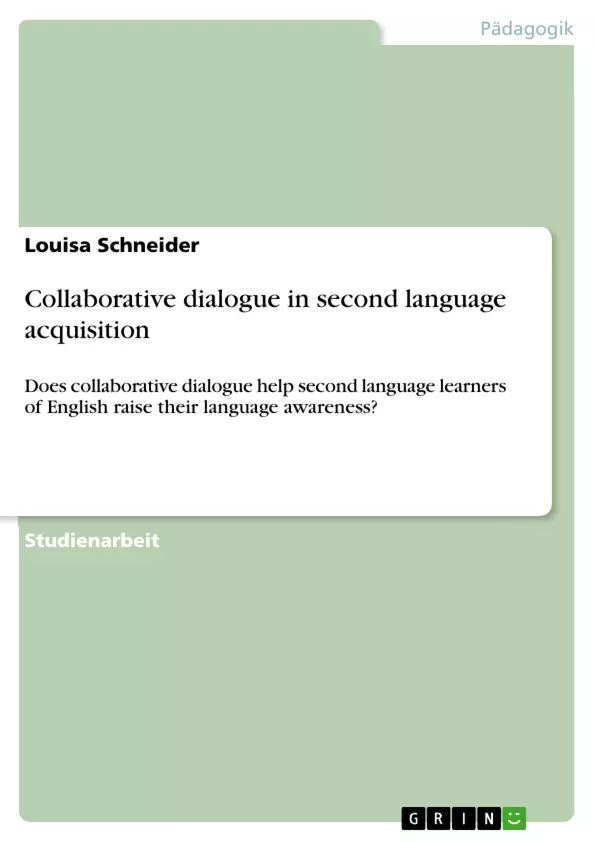The problem addressed in this study is whether collaborative dialogue helps second language (henceforth: L2) learners of English raise their language awareness. In this paper, I first give a brief overview about the theoretical context on collaborative dialogue and language related episodes (henceforth: LREs).
According to a number of different studies, which will be presented in this paper in more detail, dialogue can help us to become aware of different linguistic and pragmatic problems. Dialogue forces us to cognitively as well as socially reflect on our language used and produced.
I will then discuss the data deriving from a study focusing on the effects of collaborative dialogue. The study contains a text- reconstruction task which will be carried out and presented under consideration of the research question. Collaborative dialogue is a "joint construction of language or knowledge about language – by two or more individuals". It is generally an important part of the learning process. Learners can construct their linguistic knowledge and self- or other-repair.
The results of the study show that collaborative dialogue has a clear impact on language awareness of the students learning English: different LREs show the engagement and development of the student’s language reflection or production. Furthermore, this paper will point to the importance of collaborative dialogue in the L2 learning and will give a brief overview of what teachers are recommended to focus on while choosing different tasks.
Inhaltsverzeichnis
- Introduction
- Theoretical context
- Collaborative dialogue
- Language related episodes
- The study
- Expectations
- Participants
- Material
- Procedure
- Results and data analysis
- Application and discussion
Zielsetzung und Themenschwerpunkte
Diese Studie befasst sich mit der Frage, ob kollaborativer Dialog dazu beitragen kann, dass Zweitsprachenlerner (im Folgenden: L2) von Englisch ihre Sprachbewusstheit verbessern. Die Arbeit beleuchtet den theoretischen Kontext des kollaborativen Dialogs und der sprachbezogenen Episoden (im Folgenden: LREs), untersucht die Auswirkungen des kollaborativen Dialogs in einer Text-Rekonstruktion Aufgabe und diskutiert die Implikationen für den L2-Unterricht.
- Der Einfluss des kollaborativen Dialogs auf die Sprachbewusstheit von L2-Lernern
- Die Rolle von LREs im kollaborativen Dialog
- Die Bedeutung von Input und Output im L2-Erwerb
- Der Zusammenhang zwischen sozialer Interaktion und Spracherwerb
- Die Anwendung des kollaborativen Dialogs im L2-Unterricht
Zusammenfassung der Kapitel
- Introduction: Die Studie untersucht die Frage, ob kollaborativer Dialog die Sprachbewusstheit von L2-Lernern von Englisch verbessern kann.
- Theoretical context: Dieser Abschnitt beleuchtet die theoretischen Grundlagen des kollaborativen Dialogs und der sprachbezogenen Episoden (LREs). Es werden relevante Theorien und Studien zum Spracherwerb, insbesondere zum Output-Hypothese, vorgestellt.
- The study: Dieser Abschnitt beschreibt die Forschungsmethodik der Studie, einschließlich der Erwartungen, der Teilnehmer, des Materials, des Verfahrens und der Datenanalyse.
Schlüsselwörter
Die Studie konzentriert sich auf die Themen des kollaborativen Dialogs, der Sprachbewusstheit, der sprachbezogenen Episoden (LREs) und der Zweitsprachenforschung. Die Ergebnisse der Studie liefern wichtige Erkenntnisse zum Einfluss des kollaborativen Dialogs auf den Spracherwerb und die Sprachbewusstheit von L2-Lernern.
- Citation du texte
- Louisa Schneider (Auteur), 2019, Collaborative dialogue in second language acquisition, Munich, GRIN Verlag, https://www.grin.com/document/510283



